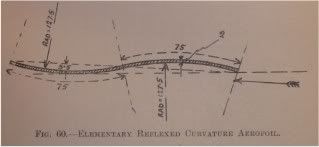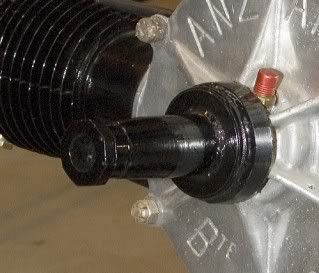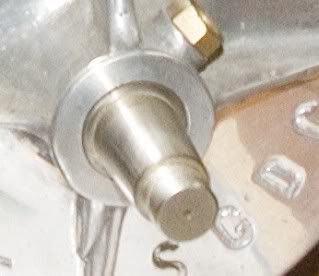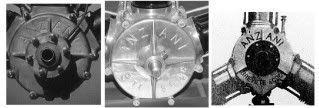Just a quick pass through here to see where is now this very interesting thread...
@Dave: "So how far "up" does a 6 degree angle go in a distance of about 660 cms?" The answer is 660 x tangent*** (6°), that is 660 x 0.105 = 69.3 cm. This number is a geometrical pitch. Numbers given by Ratmanoff are "aerodynamical" pitch: that is the true displacement of the aircraft for one turn of the engine, and he rightly calls that "advance by turn". He can't give a pitch, because his propellers have not an identical geometrical pitch along the blade.
Note that on your picture (Plan of a blade, fig 219), the geometrical pitch increases regularly along the blade because there is a constant 3° angle added to the distance proportional angle indicated by the angles written for each section.
But it is NOT the case for Ratmanoff props. The geometrical pitch increases from hub to tip, but the increase is not regular. On a figure like this for a Ratmanoff, the "added angle of 3°" is different for each section.
Note also there have to be a mistake or a miswriting (or I misread the numbers) for the "F" section: the angle can't be 25°25', but higher, around 25°55'.
*** You can use the Windows calculator (chose the "scientific display") to compute all this. Don't forget to tick the "degrees" option (by default, it is the "Radians" option which is chosen: 360°=2 x 3.14 radians). And you have also to convert sexagecimal degrees (° ' ") in decimal degrees (add to degrees number the minutes divided by 60 and seconds divided by 3600).
@Pete: Without being pedantic, I think you can read this to see how was the "thinking" about propellers in first years: http://www.archive.org/details/treat...rscr00parkuoft . It is from 1920, so already far from the 1907-1914 years, but I don't know anything in English from the first propeller making years. You will see this is not about the story of a guy who buy some boards at Home Depot... Drzewiecki writings from 1909 are as sophisticated


Not so quick pass!
Regards,
And, one more time, sorry for my rude English,
PM
@Dave: "So how far "up" does a 6 degree angle go in a distance of about 660 cms?" The answer is 660 x tangent*** (6°), that is 660 x 0.105 = 69.3 cm. This number is a geometrical pitch. Numbers given by Ratmanoff are "aerodynamical" pitch: that is the true displacement of the aircraft for one turn of the engine, and he rightly calls that "advance by turn". He can't give a pitch, because his propellers have not an identical geometrical pitch along the blade.
Note that on your picture (Plan of a blade, fig 219), the geometrical pitch increases regularly along the blade because there is a constant 3° angle added to the distance proportional angle indicated by the angles written for each section.
But it is NOT the case for Ratmanoff props. The geometrical pitch increases from hub to tip, but the increase is not regular. On a figure like this for a Ratmanoff, the "added angle of 3°" is different for each section.
Note also there have to be a mistake or a miswriting (or I misread the numbers) for the "F" section: the angle can't be 25°25', but higher, around 25°55'.
*** You can use the Windows calculator (chose the "scientific display") to compute all this. Don't forget to tick the "degrees" option (by default, it is the "Radians" option which is chosen: 360°=2 x 3.14 radians). And you have also to convert sexagecimal degrees (° ' ") in decimal degrees (add to degrees number the minutes divided by 60 and seconds divided by 3600).
@Pete: Without being pedantic, I think you can read this to see how was the "thinking" about propellers in first years: http://www.archive.org/details/treat...rscr00parkuoft . It is from 1920, so already far from the 1907-1914 years, but I don't know anything in English from the first propeller making years. You will see this is not about the story of a guy who buy some boards at Home Depot... Drzewiecki writings from 1909 are as sophisticated
Not so quick pass!
Regards,
And, one more time, sorry for my rude English,
PM




Comment